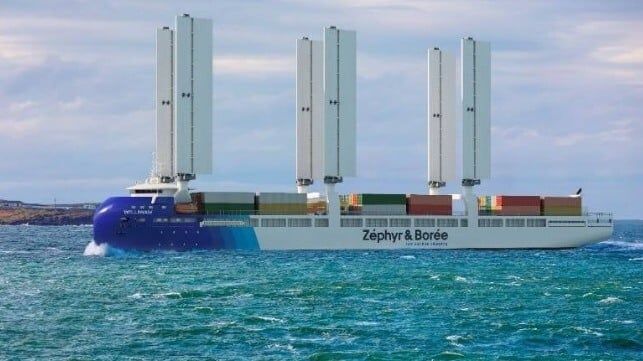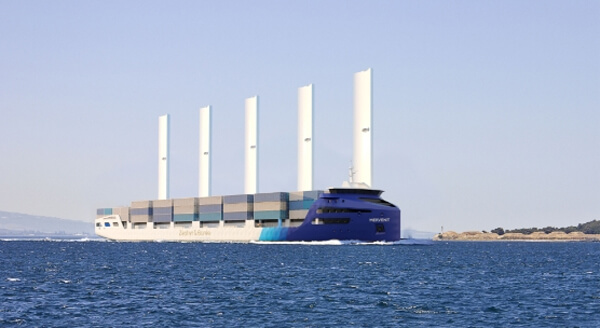GTT to Design CO2 Capture System for Hybrid Containership

France’s GTT, the engineering company best known for its containment systems for the storage and transport of LNG, has been awarded a $5 million grant to support the design of an onboard CO2 capture system that can be deployed as part of a revolutionary project, MerVent 2025. The project which involves a consortium of French companies seeks by 2025 to design, build, and operate a containership that will reduce emissions by at least 50 percent.
The MerVent project calls for the introduction of the first commercial hybrid wind-assisted containership using synthetic fuel propulsion. The design concept is for a 485-foot long vessel that would have the capacity to transport 307 containers in its cargo hold as well as an additional 380 containers loaded on deck. The vessel would have accommodations for 12 passengers and 18 in crew.
"This design of a commercial container ship with hybrid wind-assisted propulsion and synthetic fuel is the forerunner of a new generation of carbon-free merchant ships thanks to a highly innovative ship design, a hybrid propulsion, and an on-board CO2 capture system adapted to the alternative fuels currently being considered by the shipping industry,” said Philippe Berterottière, Chairman and CEO of GTT. “We are proud to bring the know-how and experience of the GTT group to the development of a low environmental impact container ship.”

Wind propulsion is a key element of the design with the vessel featuring five sail wings. They have developed a unique placement of the masts in order to better facilitate the loading and unloading of the containers. An asymmetrical arrangement of the masts allows for a clear deck plan, to secure the sail-wings in the container handling phase, and for more capacity while loading the vessel. The weight of the sails-wings will be compensated by the distribution of the masses on board the ship and by ballasting if necessary. According to the engineers, while the design requires tack sailing, the performances averaged on the two tacks show superior performance than the same ship would show with a central layout of the sail-wings.
The wings can be symmetrical (folded in two) and then placed flat on deck to secure during phases of commercial operations. The goal, however, is to use wind as the primary means of propulsion. The engineers compensate for the limited speed of the vessel by adding two removable anti-drift planes to increase stability.
While wind would be a primary source of power, the vessel also anticipates using engines powered by alternative fuels. While the goal is to use synthetic fuels, based on current availability and the 2025 goal they are considering LNG, methanol, e-GNL, and bioGNL (liquid biomethane) as the fuel sources.
To meet the goal of reducing emissions, GTT is tasked with developing an onboard capture technology solution that will capture at least 30 percent of the CO2 emissions of the alternative fuel. In addition, GTT’s digital intelligence subsidiary, OSE Engineering, will also play an essential role in the project, enabling the operational optimization of the ship's various propulsion systems.
The project is being assisted by CORIMER (Council of Orientation for the Research and Innovation of the Industrialists of the Sea) and was the winner of the group’s 2022 call for expression of interest as part of CORIMER’s efforts to structure public aid and support for projects in the sector. CORIMER brings together representatives of the components of the marine industrial sector, including shipbuilding, equipment manufacturers, oil services, energy companies, and renewable energies, as part of its mission to support research and innovation for the decarbonization of shipping.
GTT received the grant in an initiative overseen by CORIMER and funded by French public investment bank Bpifrance. The €4.66 million in funding from Bpifrance is for the design of an onboard CO2 capture system and the development of intelligent operational performance solutions.
The consortium in the MerVent 2050 project includes the shipowner Zéphyr & Borée, CWS, designer and manufacturer of the wing-sails, the Centrale Nantes University with its research teams specialized in energy optimization, OSE Engineering for the design of intelligent operational performance solutions, and GTT for the design of a CO2 capture system on board.
